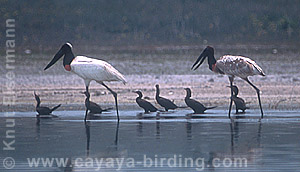Trip Report: Customized Guatemala - Birding - Loop
(14 April - 4 May 2003)
Tour leaders: Knut Eisermann & Claudia Avendaño
Participants: Ulrich Schuster, Yvette Glass, and Wiebke Schuster
Introduction
This tour was focused on enjoying bird and nature observations, Guatemalan culture, photo shootings and visiting conservation projects in Guatemala. We saw 188 bird species during this 3 weeks trip. Ornithological highlights were the Resplendent Quetzal in the Chelemhá cloud forest reserve, the Jabiru in Yaxhá, thousands of Great Egrets gathered in the shallow lagoons in Monterrico, a very close view at Crested Guan in Tikal.
14 April 2003
We welcomed the tour participants at the Guatemala City International Airport. Overnight in a hotel in Guatemala City.
15 April 2003
The strange song of Great-tailed Grackles was the first bird sound welcoming our guests in Guatemala. Having breakfast in the hotel’s garden, a Azure-crowned Hummingbird came by to drink nectar at the flowers between the tables. After breakfast we boarded our microbus and headed to Lake Atitlan along the Panamericana road. Unfortunately the view was affected by smoke, so we could not see the volcano landscape around the lake. During a short birding stop on the road which is passing around lake Atitlan we saw Eastern Bluebirds, Townsend’s Warbler, Great-tailed Grackle, Wilson’s Warbler, Bushy-crested Jay and Spotted Towhee.
In the early afternoon we arrived in Los Tarrales Reserve, on the southern slope of Atitlan volcano. Right beside the lovely Tarrales eco-lodge we discovered a nest of Rufous-naped Wrens in a palm. After lunch we explored the lower part of the reserve, which offers divers secondary habitats for birdwatching. We had nice views at White-collared Seedeaters, Golden-fronted Woodpeckers, Masked Tityra, Social Flycatcher, Sulphur-bellied Flycatcher, Clay-colored Robin, Blue-gray Tanger, Tropical Kingbird. The exotic flower plantation, which provides income to the autosustainably managed reserve, includes an amazing collection of different Heliconia species. Although coffee season was over, we learned about the work of processing coffee. In the late afternoon we observed from the eco-lodge dozens of Cattle Egrets gathered in a high tree.
16 April 2003
We started early in morning ascending the slope of Atitlan volcano by 4-WD car to an altitude of approximately 1200 m. The Humid mountain forest was full of bird voices, and we got good views at the following canopy birds Paltry Tyrannulet, White-throated Robin, Solitary Vireo, White Hawk. The trails was going down slope, offering beautiful views into the canopy.
In the understory we heard Red-crowned Ant-Tanager, Ruddy Foliage-gleaner, White-tipped Dove, and we saw and heard many Hermit Thrushes
, which were on their way to the northern breeding grounds.
After lunch back in the Tarrales eco-lodge we went to Antigua Guatemala. It was Wednesday in the Holy Week, and traditional Easter procession were going on in the streets of Antigua.

17 April 2003
During breakfast on the roof terrace of our hotel we observed Great-tailed Grackles. The shiny black males were displaying on the top of the roofs, stretching their necks strait up. White-winged Doves were constructing nest in a vine in the hotel’s garden.
After breakfast we observed Antiguan people preparing carpets made of sawdust and flowers. These carpets are elaborated along the streets of Antigua, as preparation of the Easter processions.
Then we went on to the north. We crossed Guatemala city, the pine forest zone, and then descended to bottom of the basin of the Motagua valley, the driest and hottest area in Guatemala. Various cactus species were flowering. Then we proceeded to the private protected area Ram Tzul, were we spent the night. In the last light of the day we observed Chestnut-headed Oropendulas and White-collared Swifts.
18 April 2003
In the morning we went birding to a cascade within the reserve. Highlight was a American Dipper, which we could observe for some minutes ascending the cliff. The Green-throated Mountain-gem and the Violet Sabrewing were feeding at flowers beside the stream.
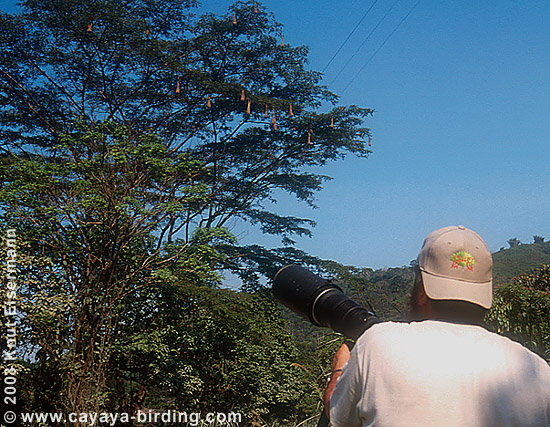
Later we started our way to the Chelemhá cloud forest reserve. We drove along the Polochic river valley, where temperature and vegetation changed quickly with descending altitude. We stopped on a tree, where Chestnut-headed Oropendulas were nesting. We observed the birds being busy bringing food for the young in the pendular nests.
From the lowest point in 400 m we started driving up slope with a 4-WD car. Along a dirt road we passed various small Maya Q’eqchi’ villages. On a viewpoint we could enjoy the impressive landscape of central Guatemala: the Sierra de las Minas mountain range behind the Polochic river valley, one of the major geologic faults in Central America. In the late afternoon we arrived in the Chelemhá cloud forest reserve, where Armin, member of the conservationist NGO UPROBON, and a Maya Q’eqchi’ family were welcoming us. We had a hot, traditional cacao drink in the small hut, and had some fun with the children and their parents, wondering about our different languages: Q’eqchi’ and German. Later we enjoyed a creative and delicious dinner in the Armin’s hut. We stayed in the Chelemha Biological station.
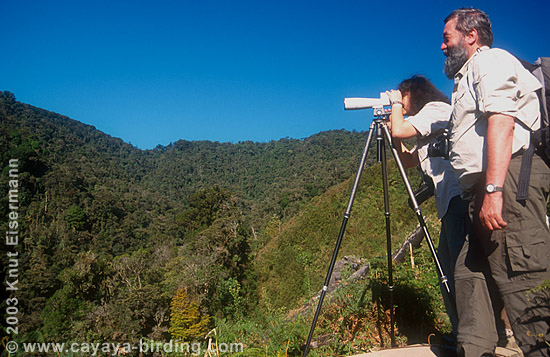
19 April 2003
We had planned a hike through the cloud forest of Chelemhá this day. We took breakfast and lunch with us. During a short break in the up-hill walk in secondary growth we could observe the canopy of the virgin cloud forest on the opposite slope. A small flock of Gray Silky-flycatchers flew by and perched on top of a dead tree. Suddenly we heard the powerful, loud screams of a group of Howler Monkeys from the opposite slope. With spotting scope we could see them for a little while before they disappeared in the green. Then we entered the cloud forest, and we saw green all around. Giant tree ferns, vines, huge trees, all covered with a thick layer of mosses. Western Wood-Pewees were calling, a Tufted Flycatcher was hunting small insects in a small gap. We listened to a cat-like, low meew - the Quetzal! Then a cuacua-cuacua-cuacua-cuacua-cuacua - the typical call during the male’s display flight. This time we could not see it, we were waiting for a little while and then went on. Reaching the mountain ridge with elfin forest, we saw laying to the north the valley of the Cahabon river and to the south the valley of the Polochic river. White-collared Swifts were passing low above our heats, cutting the air with a tremendous noise. A Red-tailed Hawk was flying over the canopy beneath us. Again we listed to Quetzals. We continued walking, passing through a wonderful forest with huge, tower like oak trees. Very quietly and carefully we entered the nesting territory of quetzals along the trail. We had good luck! The male was inside the cave in the rotten snag, its long plumes hanging out of the entrance. They seem to be golden-green fern leaves. We sat down on the trail were we could see the entrance well. The male left the cavity, sat on a branch. Nearby other Quetzals were calling, presumably also the female.
The late afternoon made us hurry to start our way back to the Biological Station, were we arrived after sunset. It was a very exhausting day, but a delicious dinner made us recover well and be ready for the next day.
20 April 2003
After a restful night and breakfast, Armin from the conservationist NGO UPROBON guided us in the agricultural model plots, were new agricultural plants and methods are tested, as alternative to the traditional slash-and-burn cultivation. Reforestation of previous corn fields with native tree species make it already possible to see Highland Guans, Quetzals and Howler Monkey within a 5 min walk from the Biological Station.
In the late morning we left Chelemhá and proceeded to the highland town of Cobán. There we visited the impressive collection of orchids "Vivero Verapaz", which is home to more than 600 species and varieties.
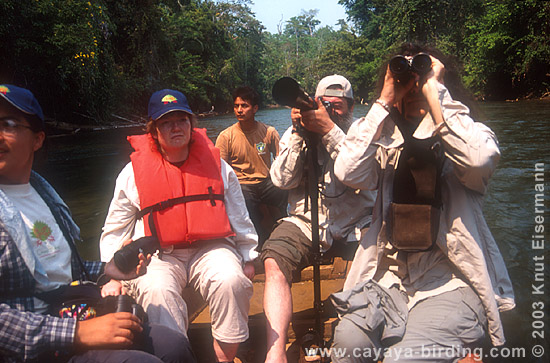
21 April 2003
We left Cobán early. On the way to the Maya Q’eqchi’ community Rocjá Pomtilá we made several stops. At Trece Aguas we enjoyed a beautiful view over a basin with several small lagoons. Great Egrets, Northern Jacanas, Purple Gallinule we saw in the distance with spotting scope. Banaquit and Yellow-winged Tanager were moving in a tree nearby. The next stop we made on a lagoon right the beside the road. There we had nice views on Ringed Kingfisher, Social Flycatcher, Mangrove Swallows, and Purple Gallinule.
Before noon we arrived in Rocjá Pomtilá, a small Maya Q’eqchi’ village on the Ik’bolay river. In small boat, made by local people, we started a wonderful excursion on the Ik’bolay river, in the middle of the rainforest. Many kingfishers (Green, Belted, Amazon) were flying along the shoreline, a Spotted Sandpiper and a Northern Waterthrush walked over a small sandbank. After an hour we arrived the area where the Ik’bolay river reemerges from the underground, after flowing 400 m through the karst. We walked between different point, where the water sputters between stones to the surface, an amazing performance by nature.
Back in the village of Rocjá Pomtilá we met the bird census takers from the bird monitoring program of the conservationist NGO PROEVAL RAXMU. In the hut of one of the men we were invited to have lunch. Everybody loved the local cuisine: calá (the young leafs of the Panama Hat Palm (Carludovica palmata), which is not a palm but a Cyclanthaceae), which grows in the secondary growth, toasted corn cobs, black beans, tortillas, and chili.

22 April 2003
The day before we still walked into the Laguna Lachuá National Park after sunset. We woke up in the middle of the rainforest with the dawn chorus all around. The small clearing at the visitors center provided good views to some of the rainforest species. White-collared Manakins were dancing in the understory. A couple of Rufous-tailed Jacamars was perching quietly on a branch. Many North American migratory birds were on their way to the breeding grounds, very abundant was the Swainson’s Thrush. In the canopy we spotted Buff-throated Saltator, Golden-hooded Tanager, Rufous-tailed Hummingbird, Yellow-throated Euphonia, Baltimore Oriole, Piratic Flycatcher.
The afternoon was for relaxing on the shore of the lagoon. Between refreshing swims we observed large groups of Eastern Kingbirds flying to the north. Thousands of butterflies were drinking minerals along the shoreline. In the very clear water we observed cichlids taking care for their young. Suddenly we heard the noises of various fluttering birds from a nearby brush - Melodious Blackbirds and a Gray Catbird were jumping and calling nervously. Something was wrong over there. Checking with spotting scope we discovered a Boa constrictor in the brush. At night we discovered another reptile. From far we saw the orange eye shine in the light of our headlamps, coming closer we saw that these eyes belonged to a young Morelett’s Crocodile
23 April 2003
After breakfast at Laguna Lachuá we walked through the rainforest to the edge of the National Park. Suddenly we heared the loud sreems of Crested Guans in canopy near the trail. We saw two bird at a glance before they went away jumping and flying through the canopy. In a small clearing we saw the Long-billed Gnatwren, and in a mixed species flock we saw the Royal Flycatcher, the Rufous Mourner and also the larger Rufous Piha. Later we entered the lek of three Long-tailed Hermits. We discovered one in the understory and had a nice view on it with spotting scope.
With our microbus we proceeded to the north, to the department El Petén. Over the cattle ranches in the widely deforested south of this department we saw Black-shouldered Kite. In the town of Sayaxché at the Passion river we had to wait for some hours. The ferry for crossing the river was broken, so we used the time for short excursion. Ruddy Ground-Dove, Tropical Kingbird and Indigo Bunting were moving the town. In a small wood aside the river we saw Tropical Gnatcatcher, American Redstart, Magnolia Warbler, and Yellow-throated Euphonia. Late in the afternoon we could proceed to El Remate at lake Petén Itzá.
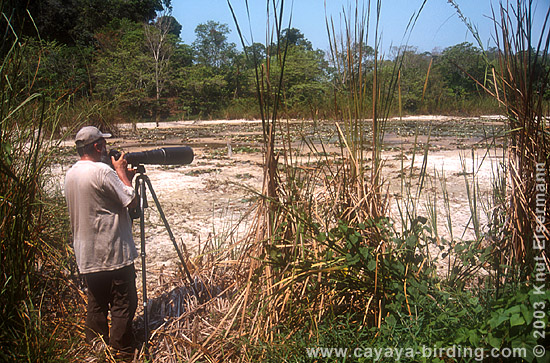
24 April 2003
The morning we dedicated to birding at the northern shore of lake Petén Itzá, with Northern Jacanas, Neotropical Cormorants, Spotted Sandpipers, Mangrove Swallows, and Tropical Pewee. Approaching a small lagoon, isolated from the lake, a raptor took off right above our heads. It was a Black-collared Hawk, an uncommon species in Guatemala. The lagoon was almost dry, with large mud areas. Migratory shorebirds were foraging there: Solitary Sandpiper, Pectoral Sandpiper, Spotted Sandpiper.
After lunch we proceeded to Yaxhá, an archaeological site and national Park in the eastern Petén. We used the late afternoon for relaxed observation on top of temple 216, overviewing the endless rainforest and the Yaxhá lagoon. With spotting scope we saw Howler and Spider Monkeys moving in the canopy.
25 April 2003
We started early in the morning. By boat we crossed lake Yaxhá, with mist all around. In the rainforest near the lake’s shore we saw a male Violaceous Trogon and a singing Scaly-breasted Hummingbird. Three Keel-billed Toucans moved high in the canopy. An agouti was foraging on fruit on the forest floor. We ascended again temple 216. Because of the mist the view was limited to a view dozens of meters. Mealy Parrots, Red-lored Parrots and White-fronted Parrots were calling from nearby trees. Collared Aracaris were foraging on palm fruits. The sun was melting the mist and uncovered the lake Yaxhá and an impressive view over the rainforest canopy. Six Plumbeous Kites started soaring over the forest. Later Gabi from the El Sombreo Eco-lodge gave us a tour through the Maya ruins of Yaxhá, explaining the history of this ancient city. The ruins are in the middle of the rainforest, so we had a combined archaeological-birding tour. We enjoyed nice views at Pale-billed Woodpeckers and Slaty-tailed Trogons.
After a siesta we started a boat excursion along the shore line of lake Yaxhá at 17:30. Many Morelett’s Crocodiles were floating in the blear water. Green Herons, Great Blue Heron, Great Egret, Little Blue Heron, Snowy Egret, Tricolored Heron and Cattle Egret were foraging in the shallow water. We saw an adult and an immature Jabiru walking in the distance. After sunset, Cattle Egret, Little Blue, Snowy, and Tricolored Heron gathered on a roosting site on a dead tree in a small bay. An Ocellated Turkey was calling in the distance.
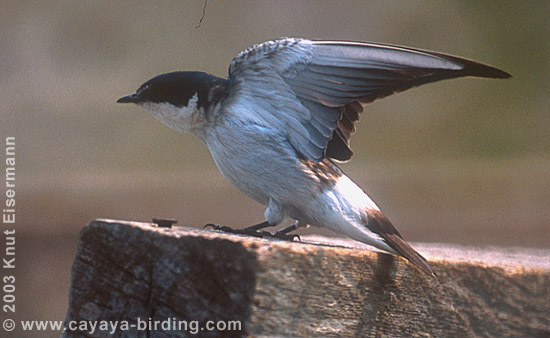
26 April 2003
We had planned an early morning excursion to the archaeological site of Topoxté in the southwestern part of lake Yaxhá. First we visited some shallow water areas, which at this time were isolated from the lake’s main water body. We saw 7 species of shorebirds. The Least Sandpiper was the most abundant one with 20 individuals, followed by the Black-necked Stilt with 10 birds. One or two individuals we saw of Semipalmated Plover, Stilt Sandpiper, Pectoral Sandpiper, Greater Yellowlegs, and Solitary Sandpiper. A very special observation was a group of 8 resting American White Pelicans. A Red-winged Blackbird male was singing on top of the shrub and a Fork-tailed Flycatcher was catching its breakfast from the top of a tall tree. Our own breakfast we enjoyed in our boat close to the shrubby shore in the bay of the ancient port of Topoxté. We were accompanied by Mangrove Swallows sitting very close and a male Northern Cardinale which singing in the shrub at the shore.
After lunch in the Sombrero Eco-lodge in Yaxhá we left for Tikal. After a little rest we entered the area of the ruins. We saw a Plumbeous Kite trinking water on the trail, which we could observe for several minutes. We saw Great Tinamou walking quitly through the understory. A noise of "something big" walking in the dry leaf litter brought our attention to a male Great Curassow.
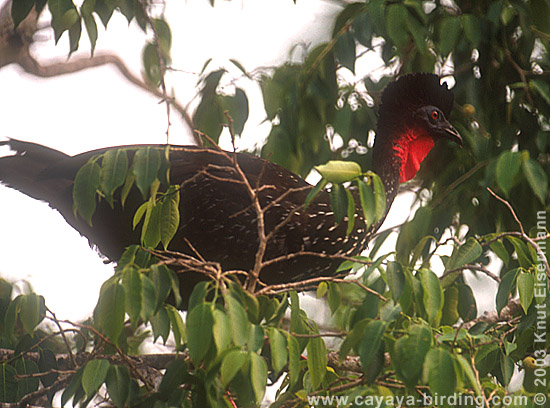
27 April 2003
We observed 79 bird species during the whole day in Tikal. At dawn we saw a Mottled Owl sitting in the midstory. The morning was crowned by a very close observation of a Crested Guan on eye-height. The guan was foraging on fruit in a small tree, we observed it from the ancient buildings of the Central Acropolis. Later flocks of White-fronted and Red-lored Parrot came to eat on the same fruit. A nesting colony of Montezuma Oropendulas beside Temple II invited us for a photo shooting. Giant Cowbirds, nesting parasites on Oropendulas, were checking on the colony and entering nests where the Oropendulas were absent.
In the afternoon we went to the Lost World and chose a pyramid as our observation platform. At the distance we saw a flock of 10 Keel-billed Toucans in a huge, leafless tree. A group of Spider Monkeys was jumping through the canopy right beside the pyramid and again we had a wonderful view at a Crested Guan.
28 April 2003
The morning we spent at the Tikal water ponds. There a Limpkin was moving almost unimpressed by our presence and we saw also the Ruddy Crake and Purple Gallinule. At a richly blooming Inga tree we saw 5 species of hummingbirds feeding on the flowers: Rufous-tailed Hummingbird, White-bellied Emerald, Green-breasted Mango, White-necked Jacobin, and Purple-crowned Fairy. Finally we saw also a group of Mexican Black Howler Monkeys.
In the late morning we proceeded southward to Guatemalan Atlantic coast. Punta de Manabique, a peninsula near the city of Puerto Barrios was our destination. This nature reserve is only accessible by boat. During the boat ride we saw Magnificent Frigatebirds, Brown Pelicans, and Laughing Gull. We had a traditional lunch containing of a special fish soup in a small village at Punta de Manabique, before proceeding to the Biological station, which is maintained by FUNDARY, a local conservationist organization. The afternoon was free for relaxing at the beach.
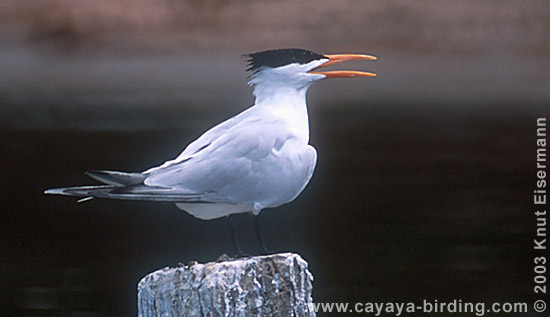
29 April 2003
Breakers were pretty high this day. Therefore it was not possible to undertake an excursion on the open sea side of the peninsula. Instead went to the Amatique Bay. On a tour with dug-out canoes along small creeks in the mangrove we saw Anhingas and we discovered a nest of the Rufous-tailed Hummingbird. Later we had nice views at the Pygmy Kingfisher and Belted Kingfisher. Along the beach of the peninsula we saw several nesting colonies of Montezuma Oropendula, established in coco palms. A Peregrine Falcon was flying over and we saw flocks of Hook-billed Kites and Broad-winged Hawks migrating northwards.
30 April / 1 May 2003
After a relaxing morning at the beach, with Royal Terns flying over, we went back to Puerto Barrios and from there to Antigua Guatemala. We went along the Motagua valley, from the humid east to very dry parts in the interior. In Antigua we visited the impressive handicraft market, where people mainly from the highlands offer textiles, woodcarvings and other handicrafts.
In the late morning of May 1st we proceeded to the Pacific coast. On the first glance of the mangrove swamp during the ferry ride to Monterrico we saw Great and Snowy Egrets. The afternoon was free to enjoy the beach.

© 2003 Knut Eisermann.
2 May 2003
At dawn we started a mangrove and reed swamp excursion in Monterrico. In the first light of the day we saw the silhouettes of several Boat-billed Herons crossing the canal between the mangrove vegetation. Their strange calls revealed that there were many of them sitting in the mangrove trees. We reached the reed swamps at good light, and turned off the small outboard motor on our boat and proceeded punting. On the reed edge along the canal many herons were standing singly in the shallow water: Great Herons, Snowy Egrets, Green Herons, Tricolored Herons, Black-crowned Night-Herons, Great Blue Herons. Cattle Egrets were flying over in small flock. Red-winged Blackbirds were singing their songs on top of the reed. Royal Terns, Laughing Gull, and very view Gull-billed Terns flew along the canal. Several Anhingas were soaring over the swamp and Neotropical Cormorants flew in lines. We saw Ruddy-breasted Seedeaters moving in the reed. We entered a smaller canal. Suddenly a Least Bittern crossed the canal flying, vanished into the and observed us. We approached very slowly the entrance to a small lagoon, where we stopped. Approximately 200 Great Egrets were standing in the shallow water. A group of about 10 American White Pelicans was swimming between them.
We proceeded slowly to a large lagoon, which was not completely accessible due to very shallow water. There we saw some species of shorebirds: Least Sandpiper, Marblet Godwit, and Black-necked Stilt. At the distance we saw several hundred Great Egret, and a flock of about 30 American White Pelicans. More than 30 Black-bellied Whistling-Ducks and about 20 White Ibis flew over in V-formation. At 8:00 the sun was burning already. On the way back to the village of Monterrico we saw adult and immature Wood Storks perching on small trees in the reed.
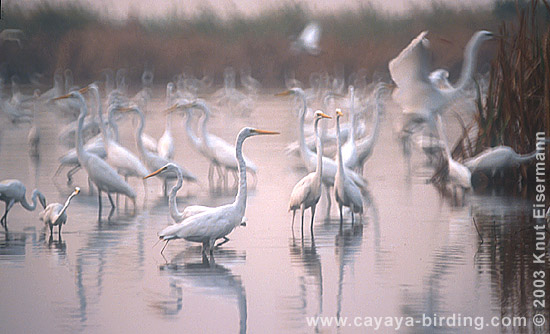
In the afternoon we dedicated to the mangrove, which is less bird rich. We saw a Least Grebe swimming in a small bay of the canal. There also Bare-throated Tiger-Heron was hunting. The most abundant heron was the Green Heron, which we saw or heard between the mangrove roots. The Mangrove Vireo was singing in the canopy and we saw a male Mangrove Warbler singing. An Osprey was perching quietly on a snag.
3 May 2003
In the morning we went again to the reed swamps, specially focused on taking photos. Although we saw the same species as on the day before, it was again very amazing to see thousands of birds moving in a small area, fed by the swamp. It was an impressive finalization of this Guatemala birding tour. After a relaxing lunch in the village of Monterrico we went back to Guatemala City where we celebrated this successful tour on our good bye dinner.
4 May 2003
We accompanied our guests to the Guatemala International airport, where we said good bye.
Knut Eisermann
List of bird species which were seen during this tour. Species only heard are not included.
- TINAMIDAE
- Great Tinamou Tinamus major
- PODICIPEDIDAE
- Least Grebe Tachybaptus dominicus
- PELECANIDAE
- American White Pelican Pelecanus erythrorhynchos
- Brown Pelican Pelecanus occidentalis
- PHALACROCORACIDAE
- Neotropic Cormorant Phalacrocorax brasilianus
- ANHINGIDAE
- Anhinga Anhinga anhinga
- FREGATIDAE
- Magnificent Frigatebird Fregata magnificens
- ARDEIDAE
- Least Bittern Ixobrychus exilis
- Bare-throated Tiger-Heron Tigrisoma mexicanum
- Great Blue Heron Ardea herodias
- Great Egret Egretta alba
- Snowy Egret Egretta thula
- Little Blue Heron Egretta caerulea
- Tricolored Heron Egretta tricolor
- Cattle Egret Bubulcus ibis
- Green Heron Butorides virescens
- Black-crowned Night-Heron Nycticorax nycticorax
- Boat-billed Heron Cochlearius cochlearius
- THRESKIORNITHIDAE
- White Ibis Eudocimus albus
- Roseate Spoonbill Platalea ajaja
- CICONIIDAE
- Jabiru Jabiru mycteria
- Wood Stork Mycteria americana
- CATHARTIDAE
- Black Vulture Coragyps atratus
- Turkey Vulture Cathartes aura
- ANATIDAE
- Black-bellied Whistling-Duck Dendrocygna autumnalis
- ACCIPITRIDAE
- Osprey Pandion haliaetus
- Hook-billed Kite Chondrohierax uncinatus
- Swallow-tailed Kite Elanoides forficatus
- White-tailed Kite Elanus leucurus
- Plumbeous Kite Ictinia plumbea
- Black-collared Hawk Busarellus nigricollis
- White Hawk Leucopternis albicollis
- Gray Hawk Buteo nitidus
- Broad-winged Hawk Buteo platypterus
- Red-tailed Hawk Buteo jamaicensis
- FALCONIDAE
- Bat Falcon Falco rufigularis
- Peregrine Falcon Falco peregrinus
- CRACIDAE
- Plain Chachalaca Ortalis vetula
- Crested Guan Penelope purpurascens
- Great Curassow Crax rubra
- PHASIANIDAE
- Ocellated Turkey Meleagris ocellata
- RALLIDAE
- Ruddy Crake Laterallus ruber
- Gray-necked Wood-Rail Aramides cajanea
- Purple Gallinule Porphyrula martinica
- Common Moorhen Gallinula chloropus
- ARAMIDAE
- Limpkin Aramus guarauna
- CHARADRIIDAE
- Semipalmated Plover Charadrius semipalmatus
- RECURVIROSTRIDAE
- Black-necked Stilt Himantopus mexicanus
- JACANIDAE
- Northern Jacana Jacana spinosa
- SCOLOPACIDAE
- Greater Yellowlegs Tringa melanoleuca
- Solitary Sandpiper Tringa solitaria
- Spotted Sandpiper Actitis macularia
- Marbled Godwit Limosa fedoa
- Least Sandpiper Calidris minutilla
- Pectoral Sandpiper Calidris melanotus
- Stilt Sandpiper Calidris himantopus
- LARIDAE
- Laughing Gull Larus atricilla
- Gull-billed Tern Sterna nilotica
- Royal Tern Sterna maxima
- Sandwich Tern Sterna sandvicensis
- COLUMBIDAE
- Red-billed Pigeon Columba flavirostris
- Band-tailed Pigeon Columba fasciata
- Short-billed Pigeon Columba nigrirostris
- White-winged Dove Zenaida asiatica
- Inca Dove Columbina inca
- Ruddy Ground-Dove Columbina talpacoti
- White-tipped Dove Leptotila verreauxi
- PSITTACIDAE
- Olive-throated Parakeet Aratinga astec
- Orange-chinned Parakeet Brotogeris jugularis
- White-crowned Parrot Pionus senilis
- White-fronted Parrot Amazona albifrons
- Red-lored Parrot Amazona autumnalis
- Mealy Parrot Amazona farinosa
- CUCULIDAE
- Groove-billed Ani Crotophaga sulcirostris
- STRIGIDAE
- Mottled Owl Strix virgata
- CAPRIMULGIDAE
- Short-tailed Nighthawk Lurocalis semitorquatus
- Lesser Nighthawk Chordeiles acutipennis
- Common Nighthawk Chordeiles minor
- Common Pauraque Nyctidromus albicollis
- APODIDAE
- White-collared Swift Streptoprocne zonaris
- Lesser Swallow-tailed Swift Panyptila cayennensis
- TROCHILIDAE
- Long-tailed Hermit Phaethornis superciliosus
- Scaly-breasted Hummingbird Phaeochroa cuvierii
- Violet Sabrewing Campylopterus hemileucurus
- Green-breasted Mango Anthracothorax prevostii
- White-bellied Emerald Amazilia candida
- Rufous-tailed Hummingbird Amazilia tzacatl
- Cinnamon Hummingbird Amazilia rutila
- Green-throated Mountain-gem Lampornis viridipallens
- Garnet-throated Hummingbird Lamprolaima rhami
- Purple-crowned Fairy Heliothryx barroti
- TROGONIDAE
- Black-headed Trogon Trogon melanocephalus
- Violaceous Trogon Trogon violaceus
- Slaty-tailed Trogon Trogon massena
- Resplendent Quetzal Pharomachrus mocinno
- MOMOTIDAE
- Blue-crowned Motmot Momotus momota
- ALCEDINIDAE
- Ringed Kingfisher Ceryle torquata
- Belted Kingfisher Ceryle alcyon
- Amazon Kingfisher Chloroceryle amazona
- Green Kingfisher Chloroceryle americana
- American Pygmy Kingfisher Chloroceryle aenea
- GALBULIDAE
- Rufous-tailed Jacamar Galbula ruficauda
- RAMPHASTIDAE
- Collared Aracari Pteroglossus torquatus
- Keel-billed Toucan Ramphastos sulfuratus
- PICIDAE
- Black-cheeked Woodpecker Centurus pucherani
- Golden-fronted Woodpecker Centurus aurifrons
- Chestnut-colored Woodpecker Celeus castaneus
- Pale-billed Woodpecker Campephilus guatemalensis
- DENDROCOLAPTIDAE
- Ivory-billed Woodcreeper Xiphorhynchus flavigaster
- Streak-headed Woodcreeper Lepidocolaptes souleyetii
- TYRANNIDAE
- Paltry Tyrannulet Zimmerius vilissimus
- Royal Flycatcher Onychorhynchus coronatus
- Tufted Flycatcher Mitrephanes phaeocercus
- Tropical Pewee Contopus cinereus
- Rufous Mourner Rhytipterna holerythra
- Brown-crested Flycatcher Myiarchus tyrannulus
- Great Kiskadee Pitangus sulphuratus
- Social Flycatcher Myiozetetes similis
- Streaked Flycatcher Myiodynastes maculatus
- Sulphur-bellied Flycatcher Myiodynastes luteiventris
- Piratic Flycatcher Legatus leucophaius
- Tropical Kingbird Tyrannus melancholicus
- Eastern Kingbird Tyrannus tyrannus
- Scissor-tailed Flycatcher Tyrannus forficatus
- Fork-tailed Flycatcher Tyrannus savana
- Rufous Piha Lipaugus unirufus
- Masked Tityra Tityra semifasciata
- PIPRIDAE
- White-collared Manakin Manacus candei
- Long-tailed Manakin Chiroxiphia linearis
- VIREONIDAE
- Blue-headed Vireo Vireo solitarius
- CORVIDAE
- Bushy-crested Jay Cyanocorax melanocyaneus
- HIRUNDINIDAE
- Gray-breasted Martin Progne chalybea
- Mangrove Swallow Tachycineta albilinea
- Northern Rough-winged Swallow Stelgidopteryx serripennis
- Ridgway’s Rough-winged Swallow Stelgidopteryx ridgwayi
- Cliff Swallow Hirundo pyrrhonota
- Barn Swallow Hirundo rustica
- TROGLODYTIDAE
- Rufous-naped Wren Campylorhynchus rufinucha
- CINCLIDAE
- American Dipper Cinclus mexicanus
- SYLVIIDAE
- Long-billed Gnatwren Ramphocaenus melanurus
- Tropical Gnatcatcher Polioptila plumbea
- TURDIDAE
- Eastern Bluebird Sialia sialis
- Swainson’s Thrush Catharus ustulatus
- Hermit Thrush Catharus guttatus
- Black Robin Turdus infuscatus
- Clay-colored Robin Turdus grayi
- White-throated Robin Turdus assimilis
- Rufous-collared Robin Turdus rufitorques
- MIMIDAE
- Gray Catbird Dumetella carolinensis
- PTILOGONATIDAE
- Gray Silky-flycatcher Ptilogonys cinereus
- PARULIDAE
- Yellow Warbler Dendroica petechia
- Magnolia Warbler Dendroica magnolia
- Yellow-rumped Warbler Dendroica coronata
- Townsend’s Warler Dendroica townsendi
- Black-and-white Warbler Mniotilta varia
- American Redstart Setophaga ruticilla
- Ovenbird Seiurus aurocapillus
- Northern Waterthrush Seiurus noveboracensis
- Common Yellowthroat Geothlypis trichas
- Wilson’s Warbler Wilsonia pusilla
- COEREBIDAE
- Bananaquit Coereba flaveola
- THRAUPIDAE
- Scarlet Tanager Piranga olivacea
- Flame-colored Tanager Piranga bidentata
- Yellow-winged Tanager Thraupis abbas
- Yellow-throated Euphonia Euphonia hirundinacea
- Golden-hooded Tanager Tangara larvata
- EMBERIZIDAE
- White-collared Seedeater Sporophila torqueola
- Ruddy-breasted Seedeater Sporophila minuta
- Yellow-faced Grassquit Tiaris olivacea
- White-naped Brush-Finch Atlapetes gutteralis
- Eastern Towhee Pipilo erythrophthalmus
- Rufous-collared Sparrow Zonotrichia capensis
- CARDINALIDAE
- Buff-throated Saltator Saltator maximus
- Black-headed Saltator Saltator atriceps
- Northern Cardinal Cardinalis cardinalis
- Indigo Bunting Passerina cyanea
- Dickcissel Spiza americana
- ICTERIDAE
- Red-winged Blackbird Agelaius phoeniceus
- Melodious Blackbird Dives dives
- Great-tailed Grackle Quiscalus mexicanus
- Bronzed Cowbird Molothrus aeneus
- Giant Cowbird Molothrus oryzivora
- Spot-breasted Oriole Icterus pectoralis
- Altamira Oriole Icterus gularis
- Baltimore Oriole Icterus galbula
- Chestnut-headed Oropendola Psarocolius wagleri
- Montezuma Oropendola Psarocolius montezuma
- PASSERIDAE
- House Sparrow Passer domesticus
Participant's comments
" 3 weeks with CAYAYA BIRDING means:
- Pure nature and culture experiences.
- 180 observed bird species under competent guiding.
- Ornithological top knowledge, also of the bird calls and songs.
- Familiar ambience all the time.
- Close-up experience of conservation projects where Cayaya Birding is involved.
- Experience of an intensive collaboration with the indigeneous people, performed on a high level in a bird monitoring program.
We thank CAYAYA BIRDING for 3 weeks full of experiences. We hope that you will have success during your conservation work, that "Quetzal & Co." can keep on flying through the rainforest."
Yvette Glass, Ulrich Schuster, Wiebke Schuster (Chemnitz, Germany)

